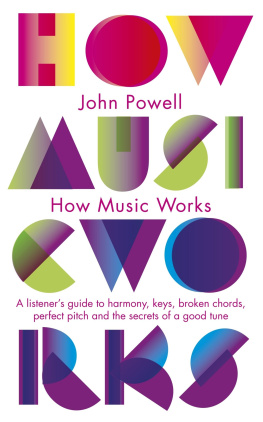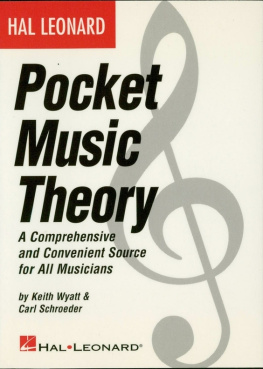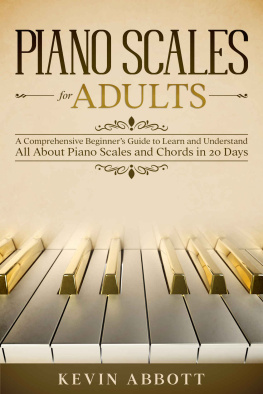How Music Works
A listeners guide to the science and psychology of beautiful sounds
JOHN POWELL

PARTICULAR BOOKS
Published by the Penguin Group
Penguin Books Ltd, 80 Strand, London WC2R 0RL, England
Penguin Group (USA) Inc., 375 Hudson Street, New York, New York 10014, USA
Penguin Group (Canada), 90 Eglinton Avenue East, Suite 700, Toronto, Ontario, Canada M4P 2Y3
(a division of Pearson Penguin Canada Inc.)
Penguin Ireland, 25 St Stephens Green, Dublin 2, Ireland (a division of Penguin Books Ltd)
Penguin Group (Australia), 250 Camberwell Road, Camberwell, Victoria 3124, Australia
(a division of Pearson Australia Group Pty Ltd)
Penguin Books India Pvt Ltd, 11 Community Centre, Panchsheel Park, New Delhi 110 017, India
Penguin Group (NZ), 67 Apollo Drive, Rosedale, North Shore 0632, New Zealand
(a division of Pearson New Zealand Ltd)
Penguin Books (South Africa) (Pty) Ltd, 24 Sturdee Avenue, Rosebank,
Johannesburg 2196, South Africa
Penguin Books Ltd, Registered Offices: 80 Strand, London WC2R 0RL, England
www.penguin.com
First published 2010
Copyright John Powell, 2010
The moral right of the author has been asserted
All rights reserved
Without limiting the rights under copyright reserved above, no part of this publication may be reproduced, stored in or introduced into a retrieval system, or transmitted, in any form or by any means (electronic, mechanical, photocopying, recording or otherwise), without the prior written permission of both the copyright owner and the above publisher of this book
A CIP catalogue record for this book is available from the British Library
ISBN: 978-0-141-95133-1
For Kim
Contents
1. So What is Music Anyway?
On my first evening as a student in Birmingham I walked into the local chip shop and asked for my favourite post-pub delicacy chips, peas and gravy. The Chinese lady looked at me quizzically and asked, Whats gravy? I was totally flummoxed. I was used to unquestioned access to gravy back in my home town, and I had no idea how to describe the stuff A sort of thin brown sauce? Fortunately the situation was saved and a whole new world of Birmingham sophistication was opened up to me when she smiled and said the magic words, Curry sauce?
This story is not about the pros and cons of gravy. The point is that sometimes we can be familiar with something we really enjoy, but have no idea what it actually is. This is the relationship most of us have with music pleasure without understanding. To my shame, I must admit that I still dont know what goes into gravy, but I have managed to untangle some of the ingredients of music, and I hope you enjoy my explanation of how musicians manage to manipulate our moods using only string, bits of wood and lengths of tubing.
This book is not based on opinions or hopeful guesswork. It is based on real information about how musical notes are produced and what happens when they combine to form a piece of music. Many people think that music is entirely built on art, but this is not true. There are rules of logic, engineering and physics underlying the whole creative side of music. The development of music and musical instruments over the past couple of millennia has depended on a continuous interplay of art and science and, speaking of advances in human understanding, I am happy to tell you that, nowadays, curry sauce and gravy are both readily available in a chip shop near you.
You will be glad to hear that you need no musical or scientific training to understand everything in this book, although musicians and scientists should find plenty of things they didnt know before. The only musical skill you will need is the ability to hum or sing two songs: Baa Baa Black Sheep and For Hes a Jolly Good Fellow and it doesnt matter how quietly or badly you sing them, I cant hear you. As far as maths skills go, it would be useful if you can add, subtract, multiply and divide, but even these skills are not essential. Also, because I am assuming that you have no training in the subject, I will explain the meaning of any specialist words I use as I go along. This may be a little over-explanatory for the musicians and scientists amongst you, but I would rather be irritating to some than baffling to others.
Throughout the book I have occasionally provided details of pieces of music that might be useful to illustrate various points. Most of these examples can be watched on YouTube or listened to through other media but they are not a necessary part of reading the book. I put them in because you might enjoy them, and because I am never going to be famous enough to appear on Desert Island Discs . If you think I have explained something badly or you need more detail, please contact me by email on howmusicworks@yahoo.co.uk and Ill see if I can come up with an answer. (This address can also be used by wealthy music firms who want to bribe me with vast sums to include references to particular bits of music in future editions of this book.)
Music covers an enormous range of subjects, from the love lives of the great composers to how to build a guitar or play the trumpet. You could say that books about the history of music cover the when questions and most other music-related books address the how to problems. This book, on the other hand, deals with some of the what and why questions about music like: what is happening to the air between the instrument and your ears? And why do such things affect your mood?
Read on, and you will discover the answers to these, and lots of other questions, including:
Whats the difference between a note and a noise?
What are minor keys, and why do they sound sad?
Why do ten violins sound only twice as loud as one?
Why do clarinets sound different from flutes?
Why are Western instruments all tuned to the same notes and why those notes, not others?
What is harmony and how does it work?
Some of these questions have already been answered in the books you will find in the physics section of the library, filed under Musical Acoustics. The only problem is that the technical nature of the subject has meant that these books use lots of maths and complicated graphs in their explanations. Books full of graphs and maths have a limited readership and this is why the only people who seem to know anything about how music works are a few badly dressed academics (and I speak with some authority here, as a badly dressed academic myself).
When I first started to study the physics and psychology of music I thought it would be straightforward. How much can there be to understand about how saxophones and harps make different sounds or why we use scales? Then I started reading. Some of the things I had thought I understood, like loudness for example, were bizarrely complicated and much more interesting than I thought they would be. To aid my own understanding I began to condense the information into simpler explanations. Eventually I realized that most of this knowledge could be presented clearly to any reader who simply loves music and has no musical or technical training. So I started to put together the notes that eventually grew into this book.
Even some top-class musicians are not familiar with the basic underlying facts about music they play their instruments and produce the correct notes in the right order without wondering how or why their instruments were designed to produce those particular notes and not others. Its as if the musicians are acting like waiters they deliver the meal to us and the food is put together by chefs (composers) from boxes of ingredients, but no one knows how or why those ingredients became available in the first place.
Next page















